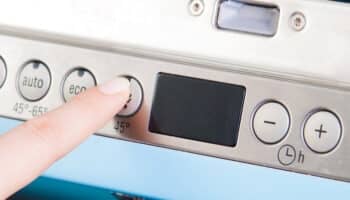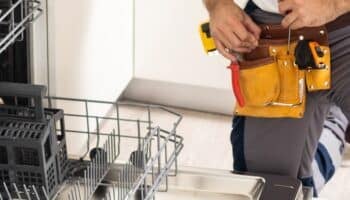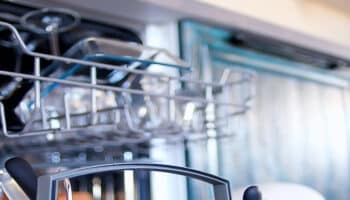We've independently reviewed this article to make sure it's as accurate as we can make it.
To find out more about our article creation and review process, check out our editorial guidelines.
Is your dishwasher not cleaning dishes?
That sucks! I understand how frustrating it can be when your dishwasher is not working as it should, especially when there’s a pile of dirty dishes waiting to be cleaned.
Luckily, you’ve come to the right place to fix the issue.
If your dishwasher is not cleaning properly, it’s probably overloaded, the filter or spray arms are clogged, or you’re using cold water. Using the wrong type and amount of detergent, drainage issues, or a faulty actuator could also explain the problem.
Read on to get your dishwasher working again!
Why trust us? This article was written by Craig Anderson and James Blackford.
Craig has helped thousands of other homeowners repair their appliances since 2016.
James is one of our resident appliance experts with over 16 years of experience. He currently works as a Master Technician for SquareTrade, and runs his own appliance repair business.
9 Reasons Why Your Dishwasher Isn’t Cleaning (With Fixes)
In this section, I’ll guide you through the nine reasons that can explain why your dishwasher isn’t cleaning properly and provide various solutions.
Keep in mind that fixing the problem will require accessing some internal components, so it’s essential to have the manufacturer’s manual handy.
Are you ready? Let’s dive in!
#1 Overloaded Dishwasher
When fixing a dishwasher that is not cleaning dishes, I always start by checking the load size.
While it can seem tempting to overload the dishwasher for quicker cleaning, doing so has the opposite effect. Overloading can block the spray arms and soap dispenser, leading to uneven cleaning.
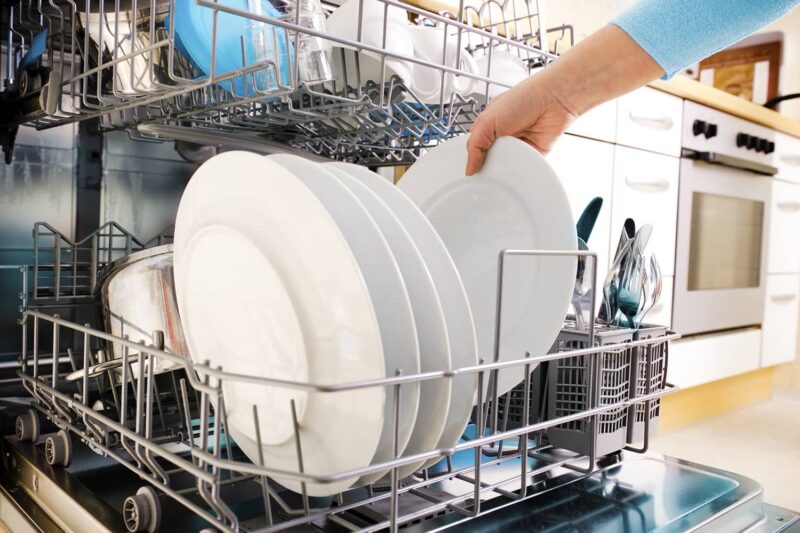
Therefore, it’s important to avoid stacking the dishes on top of one another and leave some spaces between them, Don’t forget to place your dishes facing toward the center and make sure the spray arms can move freely.
#2 Dirty Filter
I find that when a dishwasher is not cleaning properly, it’s typically due to a clogged filter.
You see, the filter is responsible for trapping food particles and debris during the washing cycle to prevent them from getting back onto your dishes. Unfortunately, if the filter gets clogged, your dishes won’t be cleaned properly.
A dirty or clogged filter can also lead to unpleasant odors and gritty glasses. So, it’s essential to check and clean the filter regularly.

Follow these simple instructions to clean your dishwasher’s filter:
- Locate the filter, which is typically at the bottom of the dishwasher. If necessary, remove the bottom rack.
- Turn the filter counterclockwise and pull it up gently.
- Use warm, soapy water and scrub the inside and outside of the filter with a wire brush. For stubborn debris, try using vinegar.
- Rinse the filter with warm water and let it dry.
- Clean the filter housing.
- Put the filter back in place and test your dishwasher.
If your dishwasher is still not cleaning dishes well, there’s likely an issue with the spray arms. Read on to learn more!
#3 Clogged Spray Arms
In my experience, clogged spray arms can also explain why your dishwasher is not cleaning properly.
You see, the spray arms have small holes that distribute water and detergent onto your dishes. If these holes become clogged with food, debris will be sprayed onto your dishes.

Here’s how to clean the spray arms.
- Turn off your dishwasher and remove the necessary racks to access the spray arms.
- Remove the spray arms.
- Use a toothpick to clear the holes. I recommend soaking the spray arms overnight in a vinegar solution if there’s significant buildup. Then, rinse them with warm water.
- Put the spray arms and racks in their place.
- Turn your dishwasher back on.
If you notice the spray arms are damaged, you’ll need a replacement. Typically, spray arms cost between $15 and $30.
#4 Your Dishwasher Is Dirty
While you’ve already taken care of the spray arms and filter, cleaning the dishwasher itself is important, as mineral deposits can accumulate in the interior and affect the unit’s cleaning performance.
My usual advice is to use a cleaning tablet once a month and a sanitizer every six months.
Note: If you prefer a natural solution, you can also place a dishwasher-safe bowl filled with white vinegar on the top rack and run the hottest cycle.
When using the sanitizer, please place it in the silverware compartment with the top facing downward. Then, run a full cycle with hot water to melt the wax seal and let the sanitizing solution clean your dishwasher.
#5 Wrong Detergent
I’ve seen that using the wrong type or amount of detergent can also affect the dishwasher’s cleaning performance.
You should only use high-quality dishwasher detergents, as they’re specifically designed to ensure the best cleaning results. Regular dish soap can result in excessive suds and dirty dishes.
Tip: Consider using an enzyme-based detergent, as it is great at breaking down grease and stubborn stains.
Using too much detergent can also leave residue on your dishes. On the other hand, using too little won’t clean them effectively.
Lastly, don’t forget that using a rinse aid is also important to prevent water spots on your dishes.
#6 You’re Using Cold Water
If your dishwasher is still not cleaning properly, you’ll need to ensure you’re using the right water temperature.
You see, hot water is more effective at breaking down grease and removing food debris. It also helps dissolve soap and ensures your dishes dry more effectively.
So, to ensure the best cleaning results, please make sure you select the hot water cycle. By running the kitchen sink tap, you can check if your dishwasher is using the correct water temperature. The water should be around 120 ºF.
If you notice that your dishwasher isn’t using hot water even after selecting the right temperature, you must test the heating element. Here’s how to do it:
- Unplug your dishwasher and gently pull it out.
- Access the heating element and carefully disconnect its wires. If necessary, refer to the manufacturer’s manual.
- Set your multimeter to the resistance setting and touch each probe to the heating element’s terminals.
- You should get a reading between 6 and 12 ohms (or the one recommended by the manufacturer). If the multimeter displays a different reading, the heating element is faulty and must be replaced.
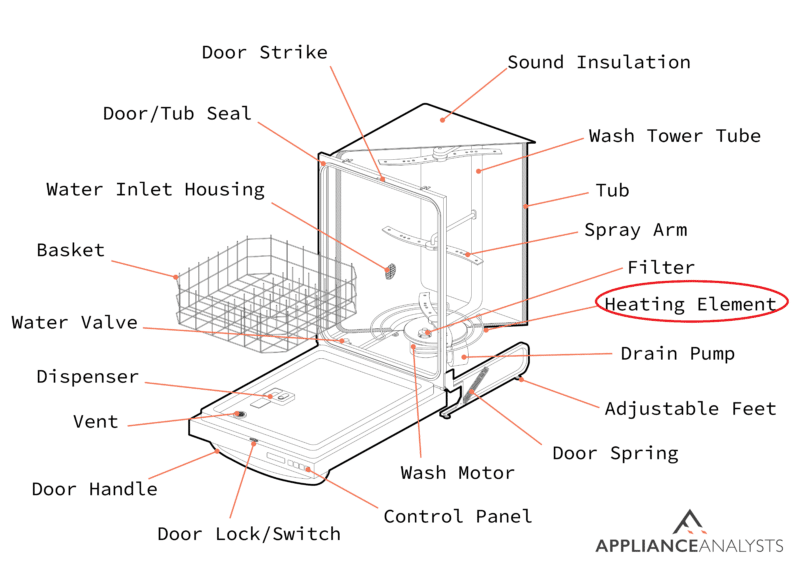
#7 Drainage Issues
Is your dishwasher still not cleaning your dishes? Then, it’s time for us to inspect the drainage system.
If your dishwasher doesn’t drain, the soiled water will recirculate in the next cycle and leave your dishes dirty. To fix the problem, double-check that the filter is clean and inspect the drain hose.
If the drain hose is kinked or clogged, please straighten it and run water through it to clear debris. You can also use a long brush. However, if the hose is broken or severely damaged, it’s time to get a replacement.
Note: Remember to follow the manufacturer’s instructions carefully when installing the drain hose. If it’s positioned too high, it can prevent the water from draining effectively.
However, if the drain hose isn’t the issue, please inspect the drain pump and remove any obstructions while wearing thick gloves. If the drain pump is damaged, it’s best to replace it with a new one.
Don’t forget that if your dishwasher is connected to the garbage disposal, you’ll need to make sure the knockout plug has been removed to ensure proper drainage.
#8 Faulty Actuator
When fixing a dishwasher that is not cleaning, I always check the actuator.
You see, modern dishwashers have an actuator that directs water flow to either the lower or upper spray arm at a given time. So, if the actuator malfunctions, it can prevent water from reaching one of the spray arms, leading to inefficient cleaning.
Unfortunately, accessing and replacing the actuator can be a bit challenging. Therefore, if you suspect your actuator is not working, it’s best to call a professional. They have the expertise and tools required to diagnose and address the issue.
#9 Water Flow Issues
If you’ve tried all the fixes mentioned in this article, but your dishwasher is still not cleaning properly, it’s likely that you’re dealing with water flow issues.
In my opinion, the easiest way to check that your dishwasher is filling as expected is by starting a cycle and slightly opening the door. If the water level seems too low, add a water pitcher and close the door.
If adding water improves your dishwasher’s cleaning performance, then it indicates there’s an issue with the water pressure, float switch, or water inlet valve. In such cases, consider calling a professional, as inspecting and repairing these components on your own could void your warranty, especially if you’re not an experienced DIYer.
Keep in mind that if you’re experiencing low water pressure, you should avoid using multiple appliances that need water at the same time.
Wrapping Up: Improving Your Dishwasher’s Cleaning Performance
Hopefully, now you know how to fix a dishwasher that is not cleaning properly.
Remember to avoid overloading your dishwasher and use the right type and amount of detergent. It’s also important to ensure you’re using hot water and clean the filter, spray arms, and interior. If the issue persists, don’t forget to check for drainage or water flow issues.
Thank you so much for taking the time to read this guide. If you’ve found it helpful, please check out our other related articles below.
Have a great day!







